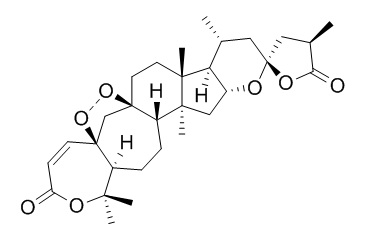Pseudolarolide Q2
Pseudolarolide Q exhibits strong antimicrobial activity against Gram-positive Staphylococcus aureus and Candida albicans at the MICs of 6.08 and 24.32 uM.
Inquire / Order:
manager@chemfaces.com
Technical Inquiries:
service@chemfaces.com
Tel:
+86-27-84237783
Fax:
+86-27-84254680
Address:
1 Building, No. 83, CheCheng Rd., Wuhan Economic and Technological Development Zone, Wuhan, Hubei 430056, PRC
Providing storage is as stated on the product vial and the vial is kept tightly sealed, the product can be stored for up to
24 months(2-8C).
Wherever possible, you should prepare and use solutions on the same day. However, if you need to make up stock solutions in advance, we recommend that you store the solution as aliquots in tightly sealed vials at -20C. Generally, these will be useable for up to two weeks. Before use, and prior to opening the vial we recommend that you allow your product to equilibrate to room temperature for at least 1 hour.
Need more advice on solubility, usage and handling? Please email to: service@chemfaces.com
The packaging of the product may have turned upside down during transportation, resulting in the natural compounds adhering to the neck or cap of the vial. take the vial out of its packaging and gently shake to let the compounds fall to the bottom of the vial. for liquid products, centrifuge at 200-500 RPM to gather the liquid at the bottom of the vial. try to avoid loss or contamination during handling.
J Food Compos Anal2017, 62:197-204
Clin Exp Pharmacol Physiol.2020, doi: 10.1111
J-STAGE2015, 249-255
Plants (Basel).2023, 12(11):2107.
Oncotarget.2017, 8(53):90925-90947
Appl. Sci.2024, 14(12), 5280.
Nutrients.2019, 11(6):E1380
Front Microbiol.2022, 13:835463.
Sustainable Chemistry & Pharmacy2022, 30:100883.
Front. Plant Sci.2022, 13:757852.
Related and Featured Products
Nat Prod Res. 2017 Nov 24:1-7.
Oxidatively rearranged cycloartane triterpenoids from the seeds of Pseudolarix amabilis.[Pubmed:
29171302]
One novel and eight known oxidatively rearranged cycloartane triterpenoids were isolated from the seeds of Pseudolarix amabilis.
METHODS AND RESULTS:
The structure of the new isolate was elucidated on extensive spectroscopic analyses. Results indicated that pseudolarolide Q (4) exhibited strong antimicrobial activity against Gram-positive Staphylococcus aureus and Candida albicans at the MICs of 6.08 and 24.32 μM, respectively. Pseudolarolide I (2) showed the 11β-HSD1 inhibitory property at the IC50 value of 34.5 nM.
Naringin 4'-glucoside
Catalog No: CFN95014
CAS No: 17257-21-5
Price: $338/5mg
Arjungenin
Catalog No: CFN95039
CAS No: 58880-25-4
Price: $318/20mg
Rebaudioside F
Catalog No: CFN95215
CAS No: 438045-89-7
Price: $268/5mg
Glaucoside A
Catalog No: CFN95299
CAS No: 81474-91-1
Price: $318/5mg
5,6,7,3',4',5'-Hexamethoxyflavanone
Catalog No: CFN95376
CAS No: 74064-17-8
Price: $318/10mg
Barbaloin-related compound B
Catalog No: CFN95455
CAS No: 473225-22-8
Price: $318/5mg
12beta-Acetoxy-3beta-hydroxy-7,11,15,23-tetraoxo-lanost-8,20-diene-26-oic acid
Catalog No: CFN95468
CAS No: 1085338-75-5
Price: $318/5mg
Malabaricone A
Catalog No: CFN95477
CAS No: 63335-23-9
Price: $318/10mg
N-Demethylfordianoside
Catalog No: CFN95589
CAS No: N/A
Price: $318/10mg
11alpha-hydroxy-3,7-dioxo-5alpha-lanosta-8,24(E)-dien-26-oic acid
Catalog No: CFN95592
CAS No: 1245703-70-1
Price: $413/5mg



